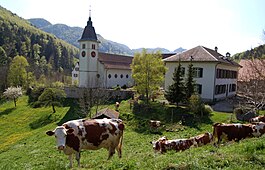Beinwil, Solothurn
| Beinwil | ||
|---|---|---|

Beinwil Abbey
|
||
|
||
| Coordinates: 47°22′N 7°35′E / 47.367°N 7.583°ECoordinates: 47°22′N 7°35′E / 47.367°N 7.583°E | ||
| Country | Switzerland | |
| Canton | Solothurn | |
| District | Thierstein | |
| Area | ||
| • Total | 22.66 km2 (8.75 sq mi) | |
| Elevation | 582 m (1,909 ft) | |
| Population (Dec 2015) | ||
| • Total | 265 | |
| • Density | 12/km2 (30/sq mi) | |
| Postal code | 4229 | |
| SFOS number | 2612 | |
| Surrounded by | Aedermannsdorf, Erschwil, Lauwil (BL), Meltingen, Mervelier (JU), Montsevelier (JU), Mümliswil-Ramiswil, Nunningen, Schelten (BE) | |
| Website |
http://www.beinwil-so.ch SFSO statistics |
|
Beinwil is a municipality in the district of Thierstein in Canton of Solothurn in Switzerland.
Beinwil is first mentioned in 1147 as Benwilre. In 1156 it was mentioned as Beinwilare.
Beinwil has an area, as of 2009[update], of 22.66 square kilometers (8.75 sq mi). Of this area, 9.88 km2 (3.81 sq mi) or 43.6% is used for agricultural purposes, while 12.26 km2 (4.73 sq mi) or 54.1% is forested. Of the rest of the land, 0.43 km2 (0.17 sq mi) or 1.9% is settled (buildings or roads) and 0.08 km2 (20 acres) or 0.4% is unproductive land.
Of the built up area, housing and buildings made up 0.6% and transportation infrastructure made up 1.2%. Out of the forested land, 50.6% of the total land area is heavily forested and 3.5% is covered with orchards or small clusters of trees. Of the agricultural land, 0.4% is used for growing crops and 26.3% is pastures and 16.2% is used for alpine pastures.
The municipality is located in the Thierstein district. It consists of scattered farm houses and small settlement clusters without a village center. It is divided into the regions of Unterbeinwil and Oberbeinwil.
The blazon of the municipal coat of arms is Sable two Bones Argent in bend sinister.
Beinwil has a population (as of December 2015[update]) of 265. As of 2008[update], 2.0% of the population are resident foreign nationals. Over the last 10 years (1999–2009 ) the population has changed at a rate of -4.7%. It has changed at a rate of -5.7% due to migration and at a rate of 3.5% due to births and deaths.
Most of the population (as of 2000[update]) speaks German (303 or 97.4%), with French being second most common (3 or 1.0%) and Serbo-Croatian being third (3 or 1.0%).
...
Wikipedia




